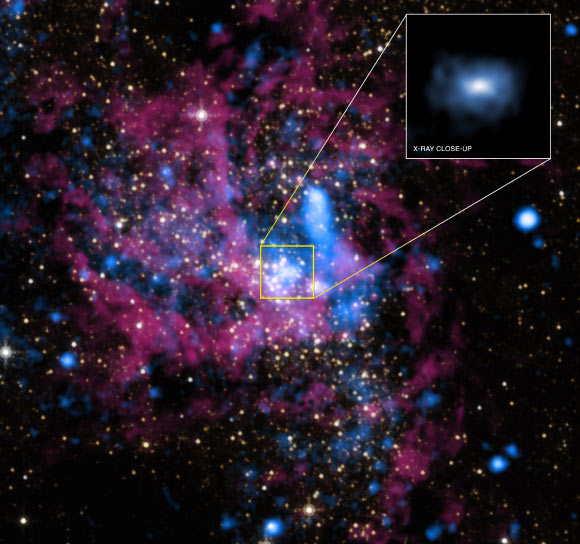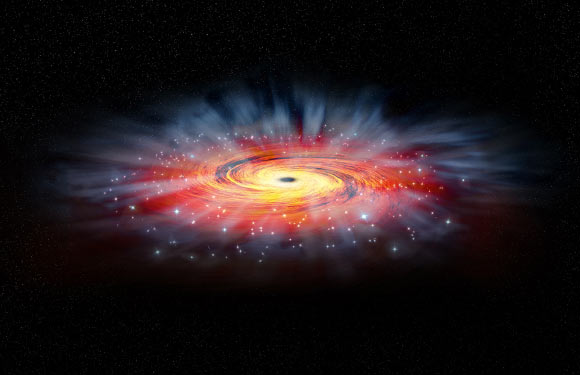An international team of astronomers using NASA’s Chandra X-ray Observatory has taken a major step in understanding why gas near the Milky Way’s supermassive black hole is extraordinarily faint in X-rays.

This image shows the region around Sagittarius A* as seen in a wider-field view of X-rays by Chandra and infrared emission from Hubble, as well as a Chandra-only image just half a light year across (X-ray: NASA / Umass / D.Wang et al.; IR: NASA / STScI).
Sagittarius A* is located about 26,000 light-years away. The new data indicate that less than 1 percent of the gas initially within Sagittarius A*’s gravitational grasp ever reaches the point of no return, also called the event horizon. Instead, much of the gas is ejected before it gets near the event horizon and has a chance to brighten, leading to feeble X-ray emission.
The scientists used Chandra to capture unusually detailed and sensitive X-ray images and energy signatures of super-heated gas swirling around Sagittarius A*, whose mass is about 4 million times that of the Sun.
“We think most large galaxies have a supermassive black hole at their center, but they are too far away for us to study how matter flows near it,” said Dr Daniel Wang of the University of Massachusetts at Amherst, who is a lead author of the study published in the journal Science (arXiv.org preprint).
“Sagittarius A* is one of very few black holes close enough for us to actually witness this process.”
Dr Wang and his colleagues found that the Chandra data from Sagittarius A* did not support theoretical models in which the X-rays are emitted from a concentration of low-mass stars around the black hole. Instead, the X-ray data show the gas near the black hole likely originates from winds produced by a disk-shaped distribution of young massive stars.
“This new Chandra image is one of the coolest I’ve ever seen. We’re watching Sagittarius A* capture hot gas ejected by nearby stars, and funnel it in towards its event horizon,” said study co-author Dr Sera Markoff from the University of Amsterdam.
To plunge over the event horizon, material captured by a black hole must lose heat and momentum. The ejection of matter allows this to occur.
“Most of the gas must be thrown out so that a small amount can reach the black hole. Contrary to what some people think, black holes do not actually devour everything that’s pulled towards them. Sagittarius A* is apparently finding much of its food hard to swallow,” said study co-author Dr Feng Yuan from Shanghai Astronomical Observatory in China.
The gas available to Sagittarius A* is very diffuse and super-hot, so it is hard for the black hole to capture and swallow it. The gluttonous black holes that power quasars and produce huge amounts of radiation have gas reservoirs much cooler and denser than that of Sagittarius A*.
The event horizon of Sagittarius A* casts a shadow against the glowing matter surrounding the black hole. This research could aid efforts using radio telescopes to observe and understand the shadow. It also will be useful for understanding the effect orbiting stars and gas clouds may have on matter flowing toward and away from the black hole.
______
Bibliographic information: Wang QD et al. 2013. Dissecting X-ray–Emitting Gas Around the Center of Our Galaxy. Science, vol. 341, no. 6149, pp. 981-983; doi: 10.1126/science.1240755








